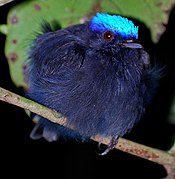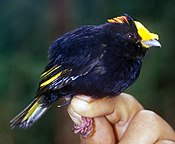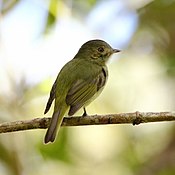
The cotingas are a large family, Cotingidae, of suboscine passerine birds found in Central America and tropical South America. Cotingas are birds of forests or forest edges, that are primary frugivorous. They all have broad bills with hooked tips, rounded wings, and strong legs. They range in size from 12–13 cm (4.7–5.1 in) of the fiery-throated fruiteater up to 48–51 cm (19–20 in) of the Amazonian umbrellabird.

Chiroxiphia is one of several genera of manakins, small song birds of South and Central America.
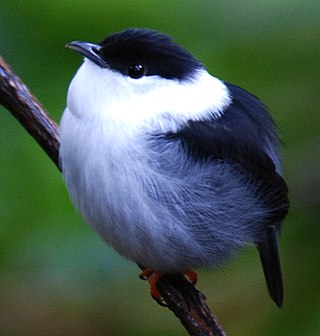
The white-bearded manakin is a small passerine bird which breeds in tropical South America. It can be found in Colombia, Venezuela and Trinidad south to Bolivia and northern Argentina. This manakin is found in forests, secondary growth and plantations. It is a small, plump bird about 10.7 centimetres (4.2 in) long. Males have a black crown, upper back, wings and tail and are otherwise white. Females are olive-green and resemble female golden-headed manakins. At breeding time, males are involved in lekking behaviour on the forest floor during which they puff out their neck feathers. This is a fairly common species with a wide range, and the International Union for Conservation of Nature has rated its conservation status as being of "least concern".

The club-winged manakin is a small passerine bird which is a resident breeding species in the cloud forest on the western slopes of the Andes Mountains of Colombia and northwestern Ecuador. The manakins are a family (Pipridae) of small bird species of subtropical and tropical Central and South America.

The white-collared manakin is a passerine bird in the manakin family. It is a resident breeder in the tropical New World from southeastern Mexico to Costa Rica and the extreme west of Panama. It typically inhabits thickets at the edges of moist forest, tall secondary growth and old cacao plantations. It is a small, plump bird about 11 centimetres (4.3 in) long. Males have a black crown, mid-back band, wings and tail, an olive-green rump and yellow belly. Females and juveniles are olive-green with yellow bellies and resemble female orange-collared manakins. At breeding time, males are involved in lekking behaviour on the forest floor during which they puff out their neck feathers. This is a fairly common species with a wide range, and the International Union for Conservation of Nature has rated its conservation status as being of "least concern".

The orange-collared manakin is a passerine bird in the manakin family. It is an endemic resident breeder in Costa Rica and western Panama, where it is found in forests, secondary growth and plantations. It is a small, plump bird about 10 centimetres (4 in) long. Males have a black crown, mid back, wings and tail and an olive-green rump. The rest of the head, neck, breast and upper back are orange, and the belly is yellow. Females are olive-green with yellow underparts and resemble female white-collared manakins. At breeding time, males are involved in lekking behaviour on the forest floor. This is a fairly common species with a somewhat restricted range, and the International Union for Conservation of Nature has rated its conservation status as being of "least concern".

The white-crowned manakin is a small passerine bird in the manakin family Pipridae. This common and extremely widespread manakin is one of the most easily identified, even in female plumage. It is a resident breeder in the tropical New World from Costa Rica to northeastern Peru and eastern Brazil. It was traditionally placed in the genus Pipra, but is now placed in its own monotypic genus Pseudopipra. It is a small, compact bird about 10 cm (3.9 in) long. Males have black plumage with a white crown which can be erected as a crest, the only member of the Pipridae to possess both an all-black body and a gleaming white crown. Females and juveniles are olive-green, with a grey head and throat, and greyish-green or olive underparts. At breeding time, males are involved in a lekking behaviour. This is a fairly common species with a wide range, and the International Union for Conservation of Nature has rated its conservation status as being of "least concern".

Manacus is a genus of passerine birds in the manakin family which are found in the forests of tropical mainland Central and South America, and on Trinidad and Tobago.

The blue manakin or swallow-tailed manakin is a small species of bird in the family Pipridae. It is found mainly in the Atlantic Forest of south-eastern Brazil, eastern Paraguay and far north-eastern Argentina. Its typical habitat is wet lowland or montane forest and heavily degraded former forest. Males have a bright blue body, black head wings and tail and a red crown. Females and juveniles are olive-green. At breeding time, males are involved in lekking behaviour when they sing and dance to impress females. This is a common species with a wide range, and the International Union for Conservation of Nature has rated its conservation status as being of "least concern".Blue Back Manakins are widely found in the Main Ridge Forest Reserve on the Caribbean Island Tobago.

The helmeted manakin is a species of small passerine bird in the manakin family Pipridae. Unlike most manakins, a family associated with tropical rainforests, the helmeted manakin inhabits the seasonally dry Cerrado savanna of Central Brazil.

The long-tailed manakin is a species of bird in the family Pipridae native to Central America where it inhabits both wet and dry tropical and subtropical forests. It is a small, plump bird about 10 centimetres (4 in) long. Males have black plumage with a blue back and a red crown, and the two central tail feathers are greatly elongated. Females and juveniles are olive-green with paler underparts. At breeding time, males are involved in a cooperative lekking behaviour with a complex coordinated courtship dance. This is a fairly common species with a wide range, and the International Union for Conservation of Nature has rated its conservation status as being of "least concern".

The pin-tailed manakin is a suboscine species of bird within the manakin family, Pipridae. This species is endemic to the Eastern coast of Brazil within the humid Atlantic Forest, and its range extends from the State of Bahia to the State of Rio Grande Do Sul. The pin-tailed manakin is monotypic within the genus Ilicura, and has no known subspecies. It is a relatively small species that has pronounced sexual dimorphism. Male birds of this species have a bright white neck, chest, auriculars, and flanks. They have black and dark-green wings, with a signature pin shape tail that has a small fork near the tip, helping to give it its common name in English. The males are most easily identified by their characteristically vibrant red fore-crown and rump. The females of this species are a muted green, except for their neck and auriculars—which are light grey, and their cream-colored chest. Both male and female birds of this species share a slightly elongated head shape that gives them a distinguished raised forehead. The pin-tailed manakin's vocalizations are quiet, but resemble a high-pitched “see-see-see” in descending tones.

Lepidothrix is a genus of passerine birds in the manakin family Pipridae. Birds in the genus are predominantly found in South America, but one species, the velvety manakin, also ranges into Central America. The females of this genus have green plumage with yellow bellies, as do some of the males. The remaining males have black plumage with white or blue crowns. Some also have yellow bellies or blue rumps.
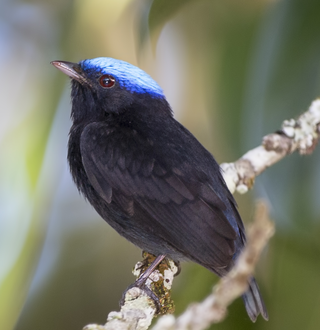
The blue-capped manakin is a species of bird in the family Pipridae. The males have a brilliant blue cap; some have black, others have green body plumage, but the relationship between the subspecies is not well understood.

The kinglet manakin or eastern striped manakin is a small South American species of passerine bird in the manakin family Pipridae. It is found in the Atlantic Forest of south eastern Brazil. It was formerly considered conspecific with the striolated manakin with the common name "striped manakin". Males have a bright red crown, which the females lack.

The golden-collared manakin is a species of bird in the family Pipridae.

The brown-winged schiffornis, is a species of Neotropical bird in the family Tityridae.

Tityridae is family of suboscine passerine birds found in forest and woodland in the Neotropics. The 45 species in this family were formerly spread over the families Tyrannidae, Pipridae and Cotingidae. As yet, no widely accepted common name exists for the family, although tityras and allies and tityras, mourners and allies have been used. They are small to medium-sized birds. Under current classification, the family ranges in size from the buff-throated purpletuft, at 9.5 cm (3.7 in) and 10 grams, to the masked tityra, at up to 24 cm (9.5 in) and 88 grams. Most have relatively short tails and large heads.

Sonation is the sound produced by birds, using mechanisms other than the syrinx. The term sonate is described as the deliberate production of sounds, not from the throat, but rather from structures such as the bill, wings, tail, feet and body feathers, or by the use of tools.

The striolated manakin or western striped manakin is a small South American species of passerine bird in the family Pipridae. It is found in west and north west Amazonia. The striolated manakin was formerly considered conspecific with the kinglet manakin with the common name "striped manakin". Males have a bright red crown, which the females lack.





